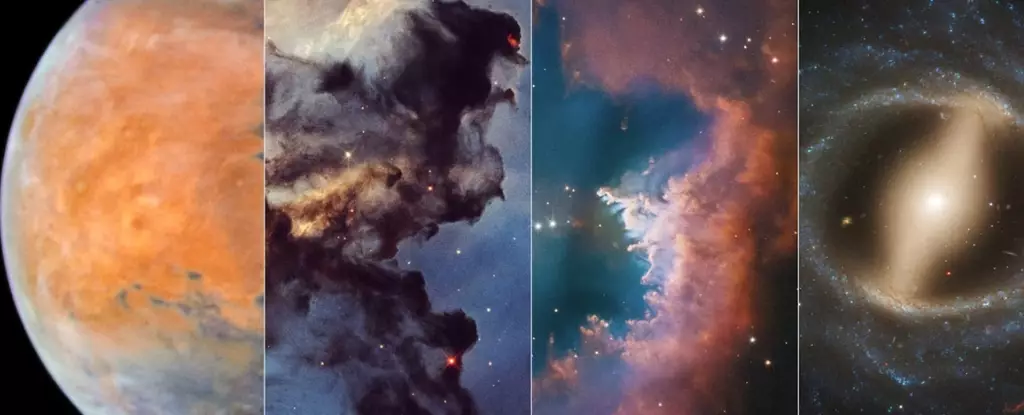This week marks a significant milestone in the world of astronomy—the 35th anniversary of the Hubble Space Telescope. Launched into Earth’s orbit aboard the space shuttle Discovery on April 24, 1990, Hubble has not just survived but thrived, continually reshaping our understanding of the cosmos. Rather than receiving birthday gifts, the Hubble team is delighted to share breathtaking new images, which illustrate its impressive legacy while inviting us to marvel at the wonders of the universe.
Shawn Domagal-Goldman, acting director of NASA’s Astrophysics Division, commemorated this anniversary, stating, “Hubble opened a new window to the universe when it launched 35 years ago.” This sentiment encapsulates Hubble’s role as more than just a telescope; it represents a transformative instrument that has created opportunities for scientific exploration we previously could only dream of.
The Rocky Start and Subsequent Triumphs
Hubble’s journey was far from flawless. After its deployment, scientists detected a troubling issue—the telescope’s primary mirror had been manufactured incorrectly, leading to blurry images. This flaw highlighted the challenges inherent in ambitious scientific endeavors. However, it also set the stage for a series of servicing missions that would dramatically enhance its capabilities.
In 1993, astronauts embarked on a daring mission to install corrective hardware, enabling Hubble to deliver its first truly stunning images of the cosmos. This turning point demonstrated not just the resilience of the technology but the ingenuity of the teams behind it. Subsequent observations have led to groundbreaking discoveries, including the detection of exoplanets, insights into black hole dynamics, and far-reaching implications about the universe’s expansion through dark energy.
Despite a critical history marked by setbacks, Hubble’s contributions have been monumental. To date, it has completed nearly 1.7 million observations across approximately 55,000 astronomical targets, culminating in over 22,000 research papers. These statistics exemplify not just Hubble’s longevity, but its continued relevance in astronomical research.
Images That Capture the Imagination
To celebrate its anniversary, Hubble has released a stunning array of images that showcase its ongoing contributions to our understanding of space. One such image highlights Mars, revealing features such as the expansive Tharsis volcano region and polar ice caps as the planet approached Earth in late December. By capturing these breathtaking details, Hubble does more than just show us the surfaces of nearby planets; it invites us to ponder the very nature of life beyond our world.
Another compelling image comes from the Rosette Nebula, a vast stellar nursery located 5,200 light-years away. The dark clouds of gas interlaced with dust provide a dramatic backdrop, making it a true cosmic portrait of creation. Such imagery not only fuels scientific inquiry but has become an artistic expression, enchanting the public’s imagination.
In addition, Hubble has provided insights into the planetary nebula NGC 2899 and the spiral galaxy NGC 5335. The latter showcases swirling streams of star formation in a galaxy characterized by a bar-shaped structure channeling gas toward its core, igniting new star formation. Each of these images encapsulates the beauty of the universe and our insatiable quest to understand it.
The Future—A Transition to New Technologies
As Hubble continues its mission, the conversation is gradually shifting towards its successor—the James Webb Space Telescope (JWST). Launched in 2021, JWST offers unprecedented light-gathering capabilities and primarily observes the universe in infrared light. While JWST is designed to explore areas of the universe that Hubble cannot, it also underscores the importance of Hubble’s multiband observation capabilities extending across the electromagnetic spectrum.
Yet, as we celebrate Hubble’s legacy, there is an undeniable sense of urgency regarding its future. Despite its successful history, the telescope experiences intermittent technical issues, raising the reality that its operational days are numbered. Discussions around the Habitable Worlds Observatory (HWO) emerge as a beacon of hope, aiming to push the boundaries of discovery further into the cosmos, potentially identifying Earth-like planets around distant stars. Designed with future servicing in mind, HWO may well represent the next chapter in humanity’s quest for cosmic knowledge.
Thus, as we celebrate the extraordinary accomplishments of the Hubble Space Telescope, we are reminded of both its remarkable journey and the exciting possibilities that lie ahead in the field of astrophysics. Embracing the complexities of our universe continues to inspire awe and ignites a collective curiosity—a legacy that Hubble has powerfully established over three and a half decades.


Leave a Reply